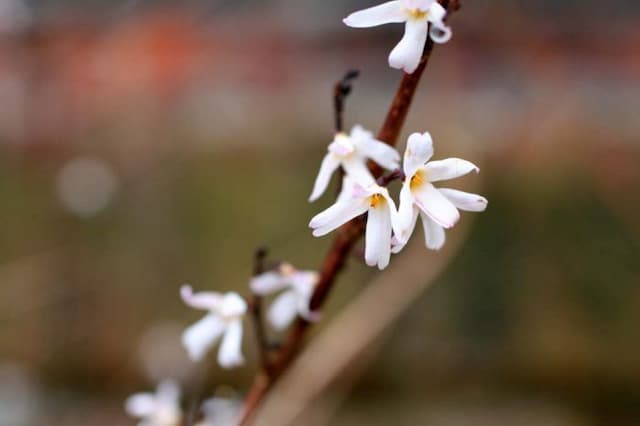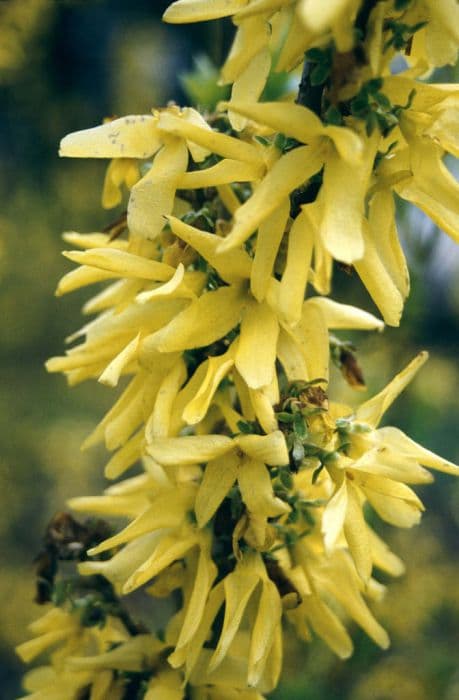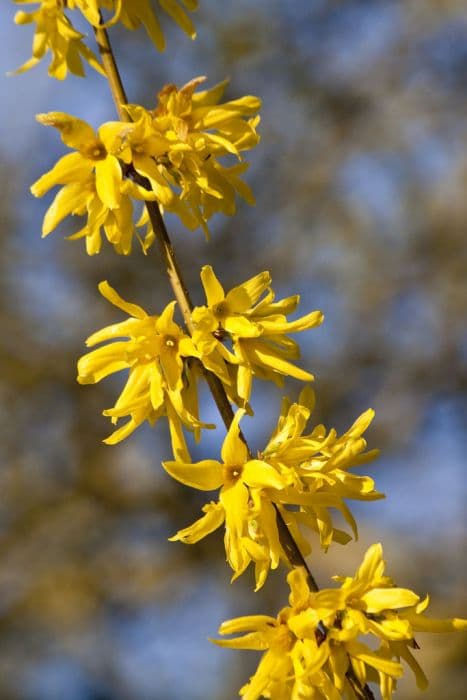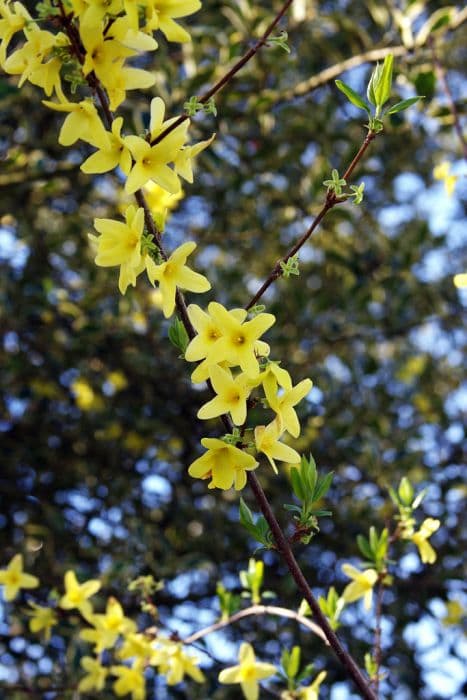False Holly Osmanthus heterophyllus 'Purpureus'

ABOUT
The plant known as Purple-Leaf False Holly has distinctive foliage that sets it apart in any garden setting. The leaves of this particular variety exhibit a rich green color with hints of purple, especially evident on the new growth. Mature leaves deepen to a more subtle green but retain purplish overtones. Each leaf is uniquely shaped, bearing a resemblance to holly with its spiny edges; however, the texture softens with maturity, becoming less prickly to the touch over time. Purple-Leaf False Holly produces small clusters of flowers that are not overly conspicuous but do add to the plant's charm. These blossoms can be white, cream, or a pale yellow, providing a delicate contrast against the dark foliage. Following the flowering period, the plant may produce small, bluish-black berries that attract birds and other wildlife, adding an extra layer of interest to its display. The overall form of Purple-Leaf False Holly is dense and bushy, providing a full and lush appearance. The contrast between the purple-tinted leaves and the more mature green foliage creates a multifaceted display of color and texture. This makes the plant a versatile choice for gardeners looking to add a touch of the unique to their landscaped spaces or seeking a resilient shrub that retains decorative appeal throughout the seasons.
About this plant
 Names
NamesSynonyms
Purple-Leaf Holly Osmanthus, False Holly, Purple Osmanthus, Variegated False Holly.
Common names
Osmanthus heterophyllus 'Purpureus'.
 Toxicity
ToxicityTo humans
False Holly is generally considered non-toxic to humans. However, consumption of any plant material may cause discomfort or an adverse reaction in some individuals. If a significant quantity of the plant is ingested, it might lead to gastrointestinal disturbances or discomfort. It's always advisable to avoid ingesting any part of an ornamental plant since their effects can be unpredictable.
To pets
False Holly is generally regarded as non-toxic to pets such as cats and dogs. While it is not known for containing any poisonous properties that might affect common household pets, it's always prudent to prevent pets from consuming plant material. Should a pet ingest large amounts of the plant, they might experience minor digestive upset such as vomiting or diarrhea. Observing for any abnormal signs and consulting with a veterinarian if any concerns arise is advisable.
 Characteristics
CharacteristicsLife cycle
Perennials
Foliage type
Evergreen
Color of leaves
Green
Flower color
White
Height
6-10 feet (1.8-3 meters)
Spread
6-8 feet (1.8-2.4 meters)
Plant type
Shrub
Hardiness zones
7
Native area
Asia
Benefits
 General Benefits
General Benefits- Ornamental Appeal: The Osmanthus heterophyllus 'Purpureus', commonly known as False Holly, adds visual interest to gardens with its purple-tinged, spiny leaves and dense, rounded growth habit.
- Year-Round Interest: It retains its foliage throughout the seasons, providing greenery even in the winter months.
- Drought Tolerance: Once established, the False Holly is relatively drought-tolerant, reducing the need for frequent watering.
- Low Maintenance: It requires minimal pruning and can thrive with basic care, making it suitable for gardeners of all skill levels.
- Fragrant Flowers: The plant produces small, fragrant flowers that can add a pleasant scent to the surrounding area.
- Habitat for Wildlife: Its berries provide food for birds, while the dense foliage can offer shelter and nesting sites.
- Suitable for Hedges: Because of its dense growth, it can be used effectively for privacy hedges or border plantings.
- Adaptability: The False Holly adapts well to a variety of soil types, though it prefers well-drained soils.
- Resistance to Pests: It has a good resistance to many common garden pests, lessening the need for chemical treatments.
 Medical Properties
Medical PropertiesThis plant is not used for medical purposes.
 Air-purifying Qualities
Air-purifying QualitiesThis plant is not specifically known for air purifying qualities.
 Other Uses
Other Uses- Osmanthus heterophyllus 'Purpureus', commonly known as "false holly," can be used as a natural dye, providing a range of colors from earth tones to yellows depending on the mordant used.
- In landscape designing, the false holly's purple young foliage and green mature leaves offer a striking contrast for themed gardens focused on color variation.
- Dried false holly leaves can add a unique fragrance when mixed with other dried flowers and herbs in potpourri arrangements.
- Osmanthus heterophyllus 'Purpureus' is sometimes used in bonsai cultivation, with its small leaves and woody stems allowing for artistic shaping.
- The dense foliage of false holly can be utilized for creating garden sculptures or topiaries due to its ability to be pruned and retain intricate shapes.
- Insect hotels or bug boxes often incorporate materials like dried false holly branches to create a suitable habitat for beneficial garden insects.
- Creative culinary enthusiasts may use the false holly berries or flowers to add a unique visual garnish to speciality dishes, despite not being commonly eaten.
- The branches of false holly, when trimmed correctly, can serve as a natural framework for climbing plants in mixed border designs.
- As a nature-inspired festive decoration, branches and berries of Osmanthus heterophyllus 'Purpureus' can be used in wreaths and floral arrangements during the holiday season.
- The resistant wood of false holly can be harvested and used in small woodworking projects such as crafting handles for handmade tools or intricate inlay work.
Interesting Facts
 Feng Shui
Feng ShuiThe False Holly is not used in Feng Shui practice.
 Zodiac Sign Compitability
Zodiac Sign CompitabilityThe False Holly is not used in astrology practice.
 Plant Symbolism
Plant Symbolism- Peace: Osmanthus is often associated with peace and is believed to bring calmness to a space, symbolizing a peaceful environment.
- Nobility: In Eastern cultures, particularly in China, the osmanthus flower is a symbol of nobility, often connected to imperial families and court life.
- Romance: The sweet fragrance of the osmanthus flower makes it a symbol of love and romance, traditionally used in weddings and courtship rituals.
- Good Fortune: Representing luck and prosperity, osmanthus is often included in celebrations and is offered as a gesture to wish someone good fortune.
- Bravery: The plant's resilience and ability to thrive in various conditions symbolize bravery and the courage to face challenges.
 Water
WaterFalse Holly ('Purpureus'), requires consistent moisture but be sure not to overwater. Water thoroughly when the top inch of soil feels dry to the touch. The frequency of watering will depend on the climate and soil type but generally, an inch of water per week either from rainfall or manual watering should suffice. During the hotter seasons, increase the water amount to 1.5 inches per week. Make sure to water directly at the soil level and avoid wetting the foliage to prevent fungal diseases.
 Light
LightThe False Holly ('Purpureus') performs best in partial to full sun conditions. A location that receives morning sun with afternoon shade or filtered light throughout the day is ideal. Avoid deep shade as it may result in fewer flowers and a less dense foliage.
 Temperature
TemperatureFalse Holly ('Purpureus') is hardy and can tolerate temperatures as low as 5°F and as high as 90°F, but it thrives best in a temperature range between 60°F to 80°F. It is important to protect the plant from extreme cold, especially during the first few years after planting until it is well established.
 Pruning
PruningPrune the False Holly ('Purpureus') to maintain its shape and promote denser foliage. The best time for pruning is late winter or early spring before new growth starts. Thin out old branches and trim back overgrown areas. You can also prune after the plant has flowered to help encourage the next season's blooms. Generally, pruning once a year is sufficient.
 Cleaning
CleaningAs needed
 Soil
SoilThe False Holly (Osmanthus heterophyllus 'Purpureus') thrives in well-draining soil with a good mix of organic matter, such as a blend of loam, peat, and sharp sand. The ideal soil pH for this shrub is slightly acidic to neutral, ranging from 6.0 to 7.5. Amending garden soil with compost when planting will enhance the soil quality for the false holly.
 Repotting
RepottingFalse Holly should be repotted every 2 to 3 years to ensure it has enough room to grow. If it becomes root-bound or the soil looks exhausted, it’s time to repot. Use the same type of soil mix recommended previously and always select a pot that is slightly larger than the previous one.
 Humidity & Misting
Humidity & MistingFalse Holly tolerates a wide range of humidity conditions, making it quite versatile. However, it appreciates moderate humidity. Aim to maintain humidity levels around 40-50% for optimal plant health. Avoid environments that are excessively dry or damp to prevent stress to the plant.
 Suitable locations
Suitable locationsIndoor
Place False Holly in bright, indirect light and maintain moderate humidity.
Outdoor
Plant in partial shade, shelter from strong winds, and mulch.
Hardiness zone
7-9 USDA
 Life cycle
Life cycleOsmanthus heterophyllus 'Purpureus', commonly known as Purpleleaf Holly Osmanthus, begins its life cycle as a seed, which after stratification germinates in the spring. The seedling then develops into a juvenile plant, characterized by rapid growth and the development of its distinctive, spiny, purple-tinged leaves. As the plant matures, it enters the vegetative state where it focuses energy on increasing in size and producing dense, evergreen foliage. Upon reaching maturity, which can take several years, it begins the reproductive stage, developing small, fragrant, white flowers in the fall, which are pollinated by insects. After pollination, it produces fruit in the form of small, blue-black berries (drupes) that contain seeds for the next generation. Finally, once the plant has lived through its productive years, it enters senescence, where growth slows and the plant eventually dies, completing its life cycle.
 Propogation
PropogationPropogation time
Late summer
Propogation: The most popular method of propagating Osmanthus heterophyllus 'Purpureus', also known as False Holly, is by semi-hardwood cuttings. This technique is generally done in late summer. Cuttings about 4 to 6 inches (10 to 15 cm) long are taken from the current year's growth. The lower leaves are removed, and the cut end is dipped in rooting hormone to enhance root development. The cuttings are then placed in a moist potting mix, ensuring at least one set of leaves is above the soil surface. A clear plastic bag or a propagation dome can be used to cover the cuttings to maintain humidity, and they are placed in indirect light until rooted, which usually takes a few weeks. After rooting, the new False Holly plants can be transplanted to individual pots or directly into the garden.








